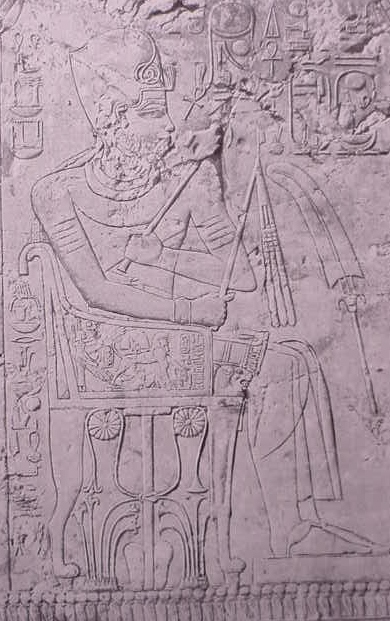Pharaoh Amenhotep III (BCE 1386-1349) seated on throne whose side panels show a Winged Sphinx trampling Asiatic enemies. It is my understanding these thrones inspired the Phoenician and Canaanite thrones whose winged sphinxes are portrayed with "extended" wings, Egyptian sphinxes' wings are not extended but against their backs. From a wall relief in the Grave of Amenemhet-Serer, No. 48. ( Tafel 11. Georg Steindorff und Walther Wolf. Die Thebanische Graberwelt. Verlag von J.J. Augustin Gluckstadt und Hamburg. 1936. Leipziger Agyptologische Studien Her ausgegeben von Walther Wolf, Professor der Agyptologie an der Universitat Leipzig. A Paperback monograph)
Note that the throne's legs are those of a lion, whose head appears near the front edge of the seat by Pharaoh's knees. So, Pharaoh is portrayed as actually "sitting" on a lion.
Below, Amenhotep III (BCE 1386-1349) seated on throne whose side panels show a "blue" Winged Sphinx trampling Nubian, Libyan and Asiatic enemies. This is a "facsimile painting" after a wall mural found in a tomb at Thebes, no. 120 of Anen, second priest of Amun (cf. fig. 155. p. 137. Gay Robbins. The Art of Ancient Egypt. Cambridge, Massachusetts. Harvard University Press. 2000. [1997 The Trustees of the British Museum London]. ISBN 0-674-00376-4 paperback)
Below, another view of the same throne. Behind Amenhotep III sits his "principal" wife Tiy. A cobra with sun disk atop its head is at the front edge of her seat near her knees. Note the Asiatic captives prostrated under Pharaoh's feet on his footrest.
Below, Tiy's throne, whose legs are that of a striped lion. Under her throne is a cavorting monkey and a spotted cat that has captured a bird (perhaps a duck ?)
